American

- Type:
- artificial reef, schooner
- Built:
- 1921, Arthur D. Story, Essex MA USA
- Specs:
- ( 125 x 18 ft )
- Sponsor:
- Cold Springs Dock
- Sunk:
- Monday June 3, 1985 - Atlantic City Artificial Reef
- GPS:
- 39°13.855' -74°12.332'
- Depth:
- 120 ft
The American was the last Grand Banks fishing schooner to operate out of Gloucester MA. The wooden vessel carried 14 dories, from which fishermen jigged cod on the Georges and Grand Banks. In 1965 she was retired to Cape May Harbor where she spent 20 years as a floating cocktail lounge.
Wally Laudeman and his wife Marijane opened The Marine Bar in 1954 as a small restaurant primarily specializing in seafood and burgers. In 1964 the Laudemans expanded into what is now The Lobster House Restaurant at Fisherman’s Wharf.
Wally had the notion to find a schooner to dock outside the eatery. He found the vessel, Roy M, a 125-foot fishing schooner built in Lundenburg, Nova Scotia. Wally had the Roy M towed down from Lundenburg, and in 1965, the renamed schooner American opened to the public. The schooner featured a bar and served burgers delivered from the restaurant.
Despite a dock fire in 1972, the American spent 20 years moored alongside the Lobster House Restaurant. But eventually, the years and Mother Nature took their toll, and in 1985 the old schooner was replaced with a new vessel.


After sinking, the wooden masts came loose and floated to the surface, and had to be retrieved. As a result, vessels like this are no longer used as reefs. Today little remains, her wooden ribbing rises from the sandy bottom, planking and scattered wreckage, are spread around the site, mostly buried in the sand. There is one section that provides higher relief, covered in anemones and hydroids. Some lobster, and cunner. Visibility is standard for the area, ranging from 20 - 40 ft.



Questions or Inquiries?
Just want to say Hello? Sign the .